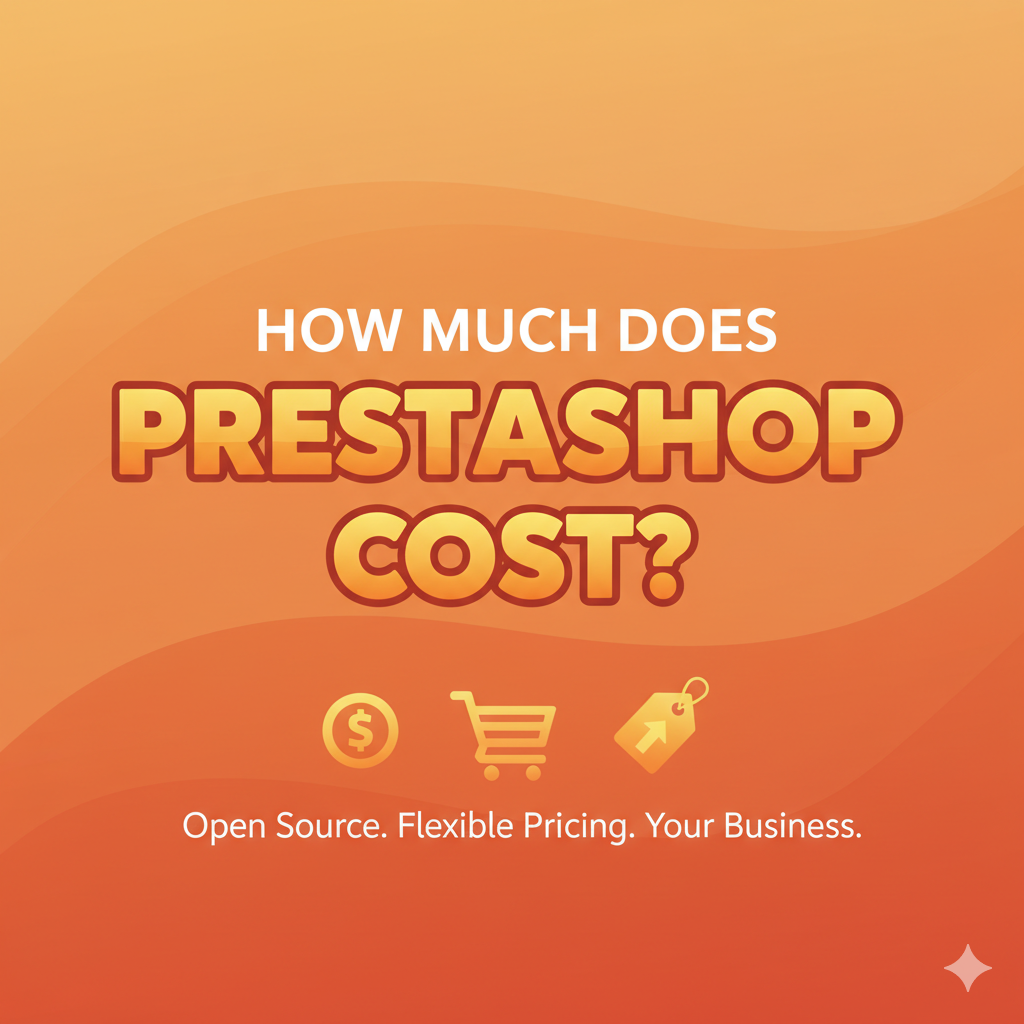So you’re thinking about starting an online store with PrestaShop? Smart choice! But let’s talk about the elephant in the room what’s this actually going to cost you?
Here’s the thing: PrestaShop itself is completely free. Yep, you read that right. Zero dollars. But (and there’s always a but), running a professional online store involves more than just the software. Let me break down the real costs so you know exactly what to expect.
The Free Part: PrestaShop Software
PrestaShop is open-source software, which means you can download and use it without paying a cent. It’s yours to customize, modify, and use however you want. No monthly subscription fees, no percentage of your sales going to the platform, and no surprise charges when you start making money.
This is a big deal. While platforms like Shopify, BigCommerce, or Wix charge you monthly just to use their software, PrestaShop gives you full control without those recurring platform fees.
Cost: $0
But remember, “free software” doesn’t mean “free store.” Let’s look at what you’ll actually need to spend.
The Must-Have Costs
These are the non-negotiables. Every online store needs these, whether you’re using PrestaShop or any other platform.
1. Web Hosting ($5–$200+ per month)
Your store needs a home on the internet, and that’s where hosting comes in. Think of it like renting space for your physical shop – except this one’s digital.
Here’s what your options look like:
Shared Hosting ($5–15/month) This is the budget-friendly option. Your website shares server resources with other sites. It’s perfect when you’re just starting out with limited traffic. Companies like Bluehost, HostGator, and SiteGround offer PrestaShop-compatible shared hosting.
VPS Hosting ($20–80/month) Virtual Private Server hosting gives you more power and resources. It’s like having your own apartment instead of sharing a dorm room. This is ideal when your store starts getting consistent traffic and you need better performance.
Dedicated or Cloud Hosting ($50–200+/month) This is the premium option for serious businesses. You get an entire server to yourself, which means maximum speed, security, and reliability. Cloud hosting from providers like AWS, Google Cloud, or DigitalOcean falls into this category.
My take: Start with good shared hosting ($10–15/month) or entry-level VPS ($20–30/month). You can always upgrade as your business grows. Don’t overspend on hosting before you have customers.
2. Domain Name ($10–20 per year)
This is your website address, like www.yourstore.com. You’ll need to register it through domain registrars like GoDaddy, Namecheap, or Google Domains.
Most domains cost around $12–15 per year, though premium or short domains can cost much more. Some hosting providers throw in a free domain for the first year, which is a nice bonus.
Cost: Around $12–15/year
Pro tip: Choose a domain that’s easy to remember, spell, and type. Your customers will thank you.
3. SSL Certificate ($0–$100 per year)
This is the technology that secures your website and shows that little padlock icon in the browser. It encrypts data between your customers and your server, which is absolutely essential for any site handling payments or personal information.
Good news: Most hosting providers now include free SSL certificates through Let’s Encrypt. If they don’t, you can purchase one for $50–100/year.
Cost: $0–50/year (usually free with modern hosting)
Without SSL, browsers will show scary “Not Secure” warnings, and your customers will run for the hills. Plus, Google ranks secure sites higher in search results.
The “You’ll Probably Need These” Costs
These aren’t technically required, but let’s be honest – you’ll want them for a professional, functional store.
4. Premium Theme ($50–$200 one-time)
PrestaShop comes with some free themes, but they’re pretty basic. A premium theme is like choosing between wearing a T-shirt or a tailored suit to a job interview. Both cover you, but one makes a way better impression.
Premium themes from marketplaces like PrestaShop Addons or ThemeForest typically cost $50–150. They come with:
- Professional, modern designs
- Mobile responsiveness (crucial since over 50% of shopping happens on phones)
- Better customization options
- Regular updates and support
- Built-in features that would otherwise require extra modules
Cost: $50–150 typically
Some themes are more expensive ($200–300) but include tons of built-in features that save you money on modules later.
5. Essential Modules & Extensions ($0–$500+)
Here’s where PrestaShop really shines – and where costs can vary widely. Modules are like apps for your store. They add specific features and functions.
Free modules are available for basic needs, but premium modules usually work better and come with support.
Essential modules you’ll likely need:
- Advanced payment gateways ($0–100) – Beyond basic PayPal
- Shipping calculators ($0–80) – Real-time shipping rates
- SEO optimization tools ($0–100) – Help people find your store
- Email marketing integration ($0–50) – Connect with Mailchimp, etc.
- Security and backup modules ($50–150) – Protect your store
- Analytics and reporting ($0–80) – Understand your customers
A realistic starter pack of quality modules might run $100–300. As your store grows, you might add more specialized modules for things like abandoned cart recovery, product reviews, or advanced inventory management.
Cost: $100–500 for a solid foundation
6. Payment Processing Fees (2–3% per transaction)
This isn’t really a PrestaShop cost – it’s a cost of doing business online. Every platform has this.
When customers pay you through PayPal, Stripe, credit cards, or other payment methods, the payment processor takes a small percentage plus a fixed fee per transaction.
Typical rates:
- PayPal: 2.9% + $0.30 per transaction
- Stripe: 2.9% + $0.30 per transaction
- Traditional merchant accounts: 2.5–3.5% depending on your deal
Cost: Usually 2.5–3% + $0.30 per transaction
The good news? You only pay these fees when you make sales. No sales = no fees.
Optional But Often Worth It
7. Professional Development ($500–$5,000+)
PrestaShop is fairly user-friendly, but if you want custom features, unique designs, or need help with technical setup, hiring a professional can save you tons of time and frustration.
What developers can do for you:
- Custom theme design ($1,000–3,000)
- Module customization ($200–800)
- Initial setup and configuration ($300–800)
- Custom feature development ($500–2,000+)
- Performance optimization ($200–500)
You can find PrestaShop developers on platforms like Upwork, Fiverr, or PrestaShop’s official partner network. Rates vary wildly based on location and expertise.
Cost: $500–$5,000+ (highly variable)
8. Maintenance & Updates ($0–$200/month)
Your store needs regular care: security updates, backups, performance monitoring, and occasional troubleshooting. You can handle this yourself if you’re tech-savvy, or hire someone to do it.
DIY approach: Free, but requires time and technical knowledge Managed service: $50–200/month for professional maintenance
Many hosting providers offer managed PrestaShop hosting that includes maintenance, which can be a smart investment.
9. Marketing & SEO Tools
To actually get customers, you’ll need to invest in marketing:
- Google Ads budget: Variable
- Facebook/Instagram ads: Variable
- SEO tools (like SEMrush or Ahrefs): $100–400/month
- Email marketing (Mailchimp, Klaviyo): $0–50+/month
These costs are separate from your store platform but are essential for growth.
The Bottom Line: Real-World Cost Scenarios
Let me give you three realistic scenarios based on different business stages:
Scenario 1: Bootstrap Startup (Minimal Investment)
Perfect for testing an idea or starting really small:
- Hosting: $10/month ($120/year)
- Domain: $15/year
- Free SSL: $0
- Free theme: $0
- Free modules only: $0
- DIY setup and maintenance: $0
- Total first year: ~$135
This works if you’re tech-savvy and willing to learn as you go. You’ll spend time instead of money.
Scenario 2: Small Business Setup (Recommended for Most)
The sweet spot for serious entrepreneurs:
- Quality hosting: $30/month ($360/year)
- Domain: $15/year
- SSL: Free with hosting
- Premium theme: $100
- Essential modules: $200
- Basic developer setup: $500
- Total first year: ~$1,175
This gives you a professional store without breaking the bank. You’ll have the tools you need to compete and grow.
Scenario 3: Professional Store (Established Business)
For those who want everything done right from day one:
- Premium VPS/Cloud hosting: $80/month ($960/year)
- Domain + premium SSL: $65/year
- Premium theme: $150
- Premium modules: $500
- Professional development: $2,000
- Managed maintenance: $100/month ($1,200/year)
- Total first year: ~$4,875
This is the investment level for a serious e-commerce business that wants professional quality and ongoing support.
PrestaShop vs. Other Platforms: The Real Cost Comparison
Let’s put this in perspective. Here’s what other popular platforms charge just for the software:
Shopify:
- Basic: $39/month ($468/year)
- Shopify: $105/month ($1,260/year)
- Advanced: $399/month ($4,788/year)
- Plus transaction fees if not using Shopify Payments
BigCommerce:
- Standard: $39/month ($468/year)
- Plus: $105/month ($1,260/year)
- Pro: $399/month ($4,788/year)
Wix:
- Business Basic: $27/month ($324/year)
- Business Unlimited: $32/month ($384/year)
- Business VIP: $59/month ($708/year)
With PrestaShop, you’re saving hundreds to thousands annually on platform fees alone. Yes, you need to invest in hosting and other essentials, but you would need those with any platform. The difference is you’re not paying monthly just to use the software.
My Honest Advice for Getting Started
Here’s what I’d do if I were starting a PrestaShop store today:
Start smart, not cheap:
- Get reliable hosting ($20–30/month) – don’t go with the absolute cheapest option
- Invest in a good theme ($80–120) – first impressions matter
- Buy only the modules you need right now ($100–200) – you can add more later
- Consider hiring help for initial setup ($300–500) if you’re not technical
First-year budget: $800–1,500
This gives you a professional foundation without overspending before you’ve made your first sale.
Then scale with revenue: As your store makes money, reinvest in:
- Better hosting for faster load times
- Additional modules for more features
- Professional maintenance services
- Marketing tools and campaigns
The Real Question You Should Ask Yourself
It’s not “how much does PrestaShop cost?” but rather “how much am I willing to invest in building a successful online business?”
The beauty of PrestaShop is flexibility. You can start lean and grow strategically. The software being free means you control where your money goes – into the things that actually drive sales and growth, not into monthly platform fees.
Conclusion
PrestaShop in 2025 remains one of the most cost-effective e-commerce solutions available. The free software means lower barriers to entry and more control over your costs. Whether you spend $135 or $5,000 in your first year depends entirely on your needs, skills, and ambitions.
The platform is powerful enough for major brands but accessible enough for solo entrepreneurs. That’s a rare combination.
Quick Summary:
- PrestaShop software: FREE
- Basic store setup: $135–$800/year
- Professional setup: $1,200–$5,000/year
- Ongoing costs: Primarily hosting, with optional modules and services as needed
The best part? No monthly platform fees eating into your profits. Every sale you make is truly yours (minus standard payment processing fees that everyone pays).
Discover more from PratsDigital
Subscribe to get the latest posts sent to your email.


Pingback: How to Accept Payments with PrestaShop - PratsDigital